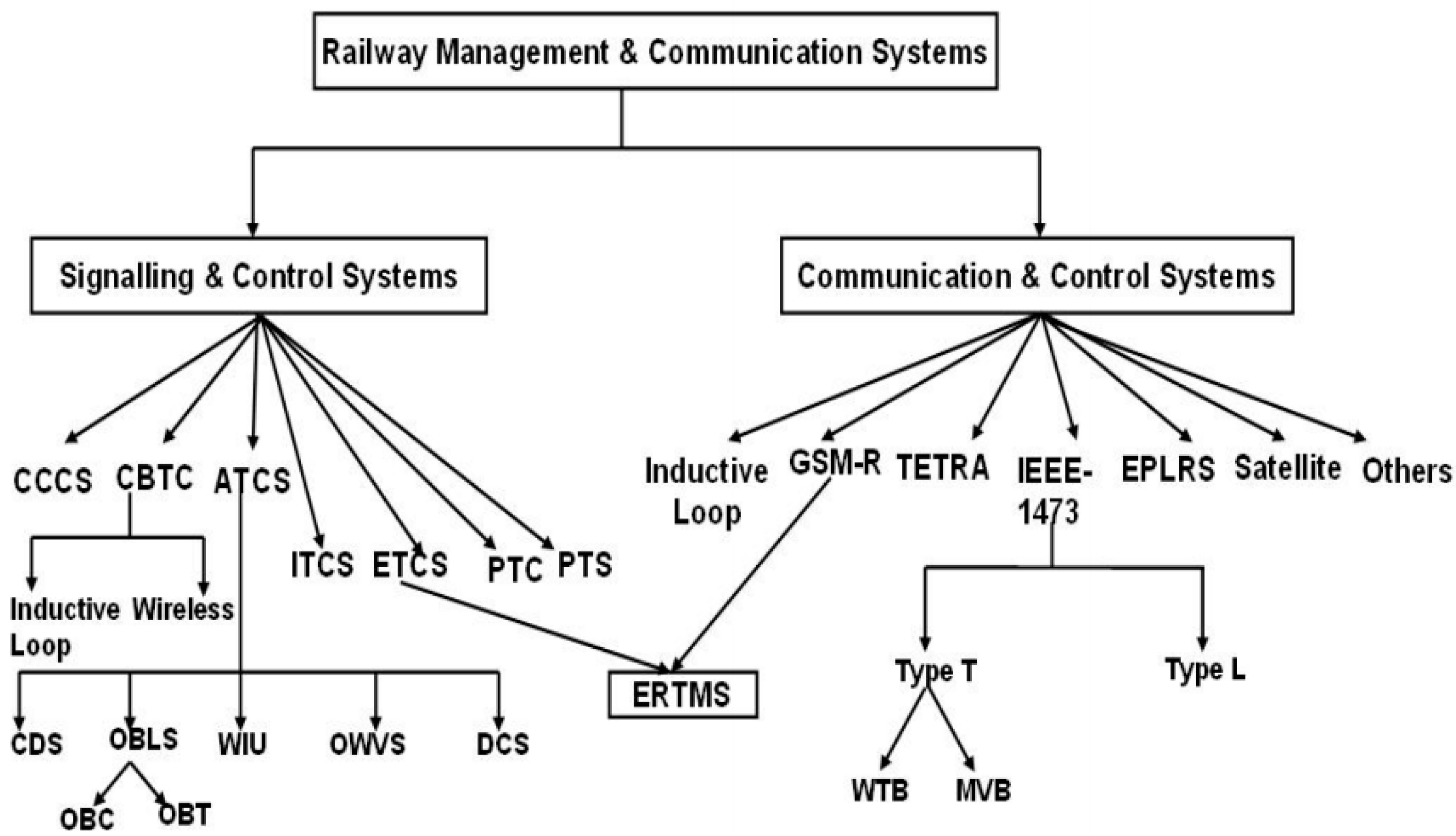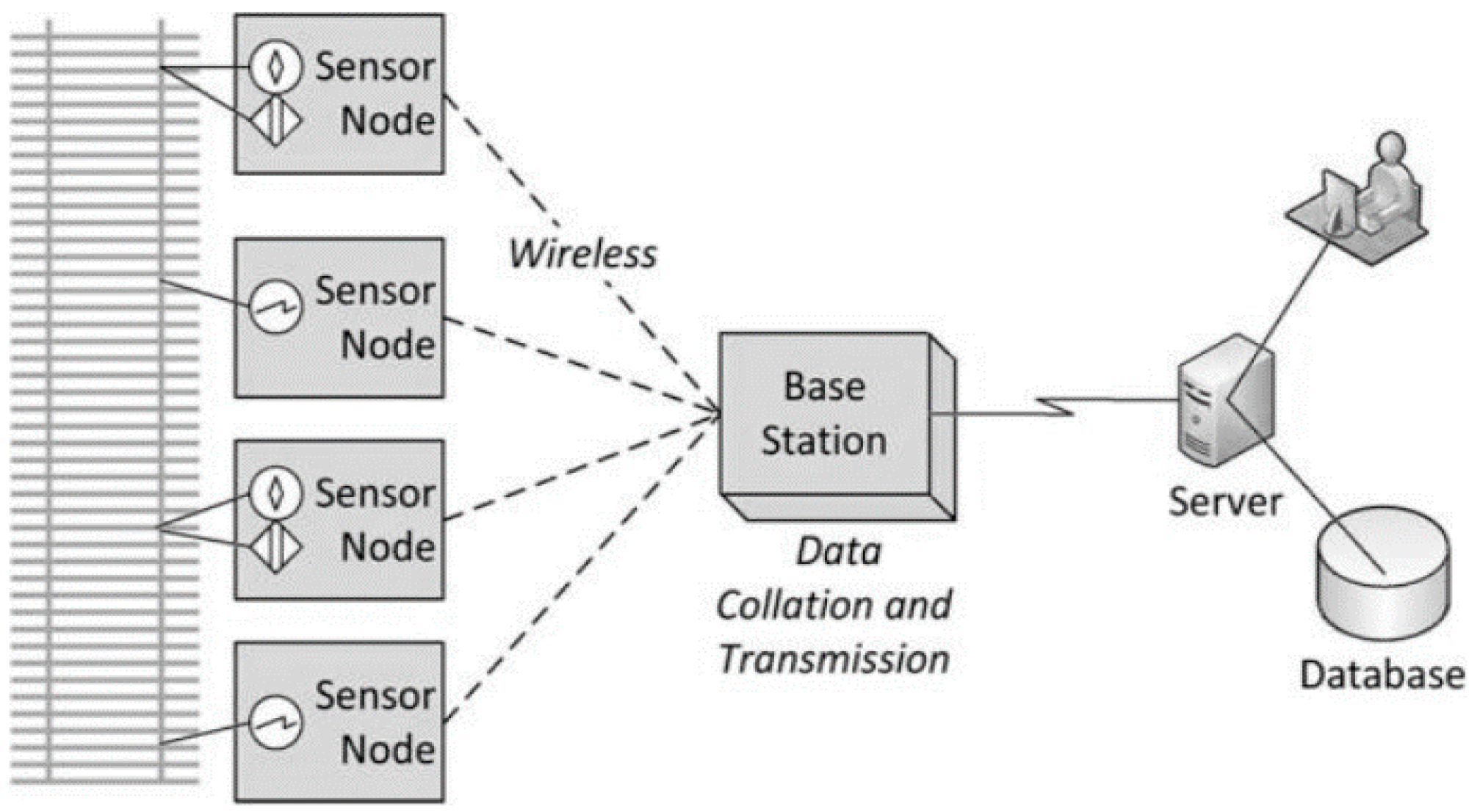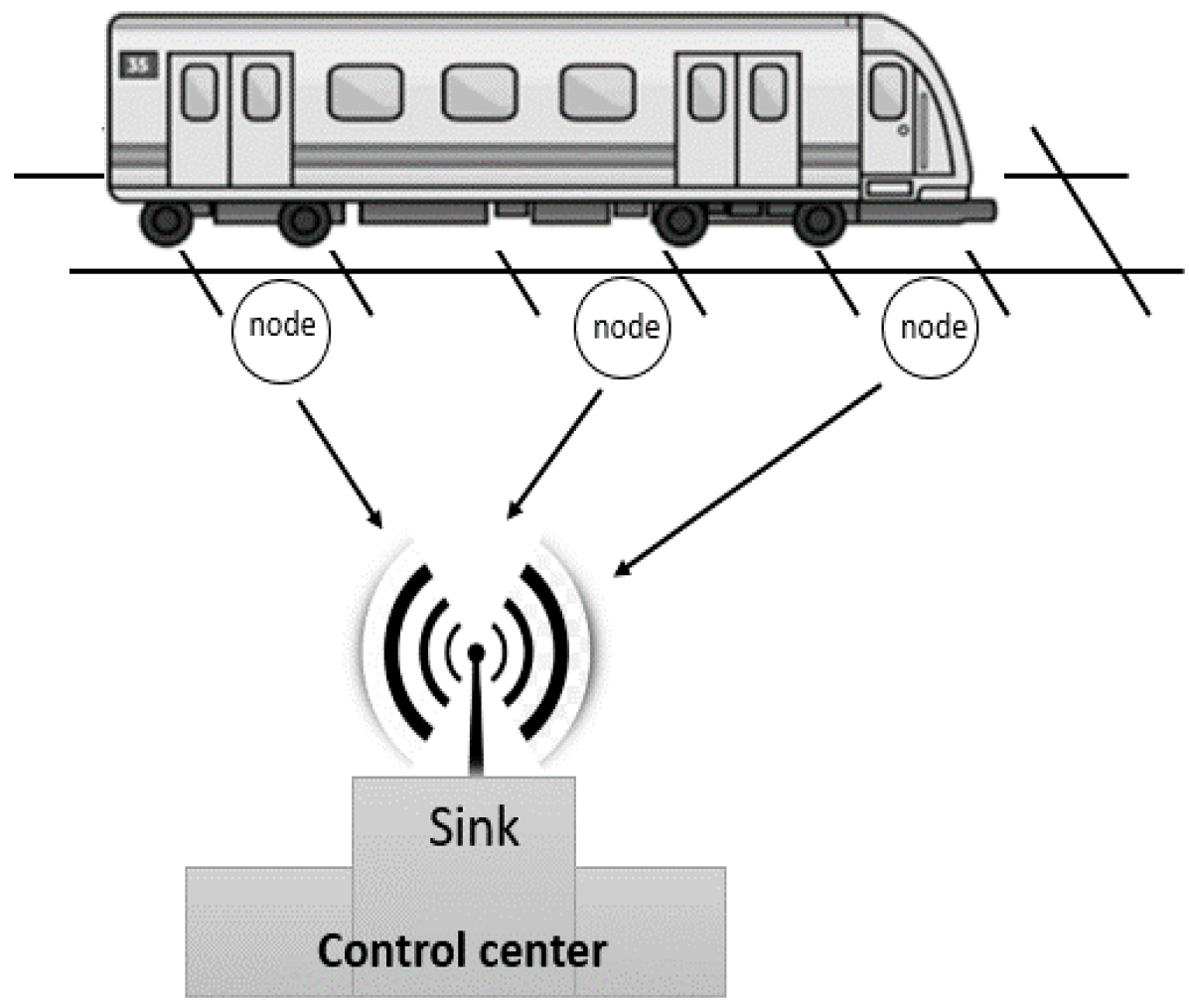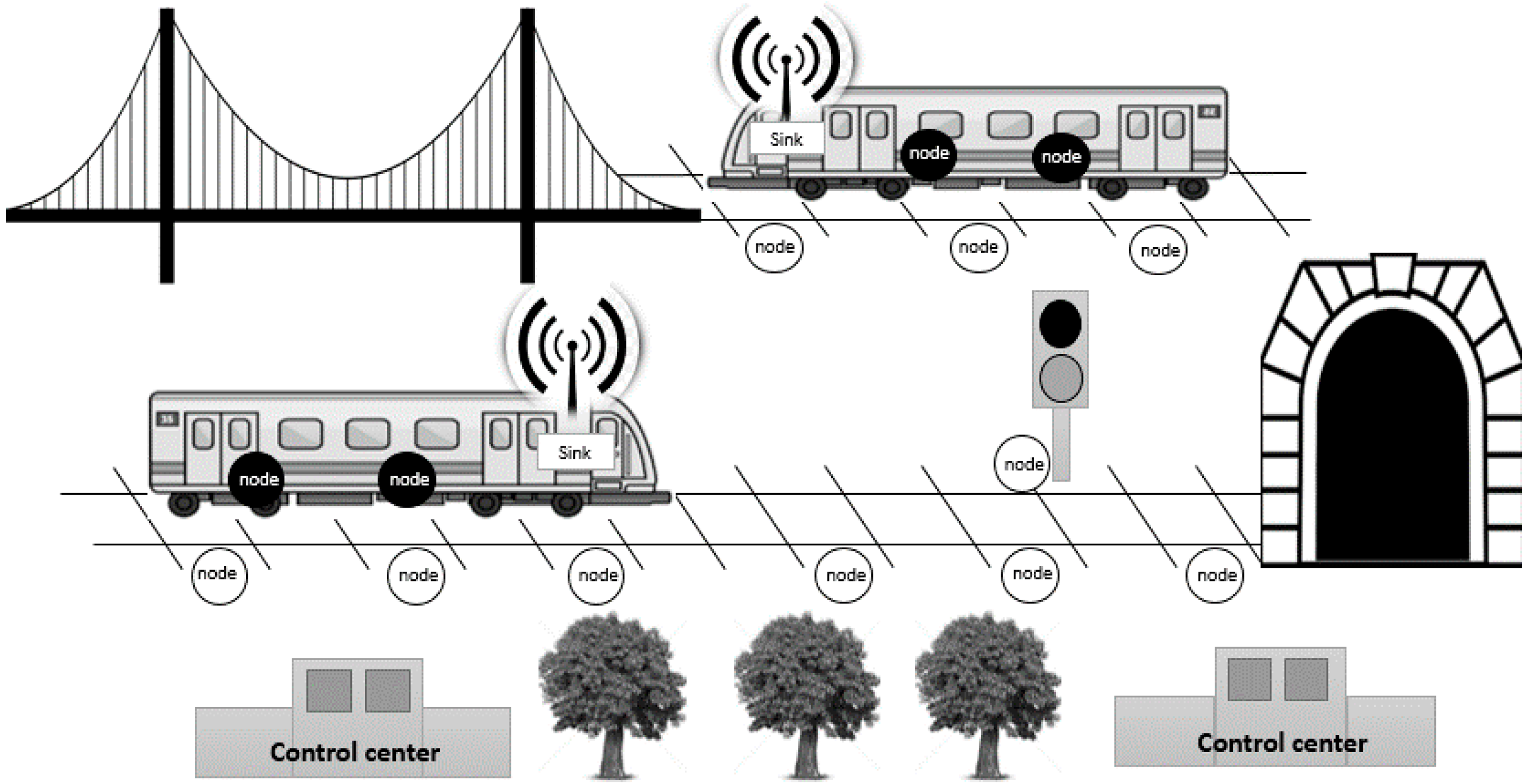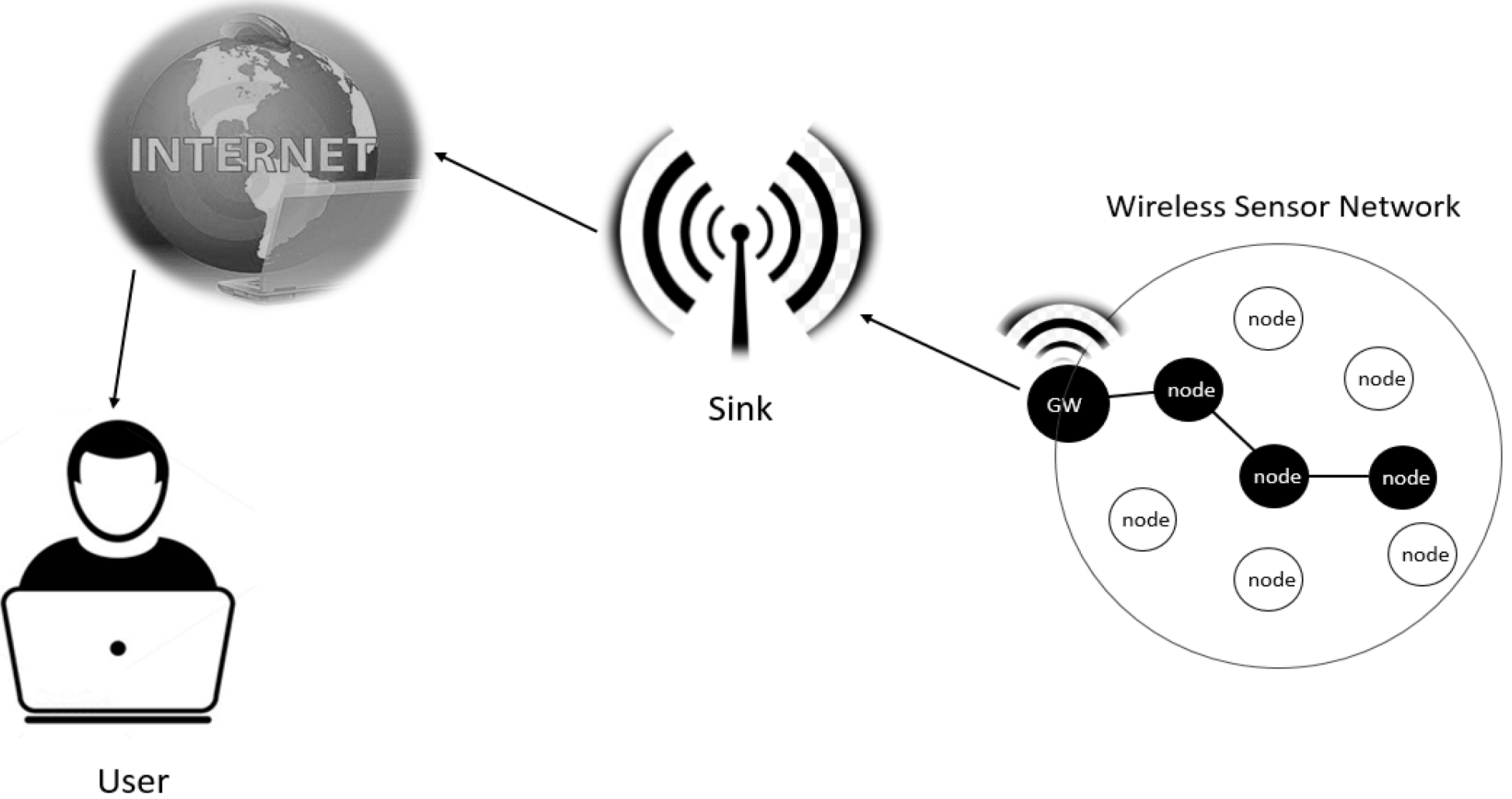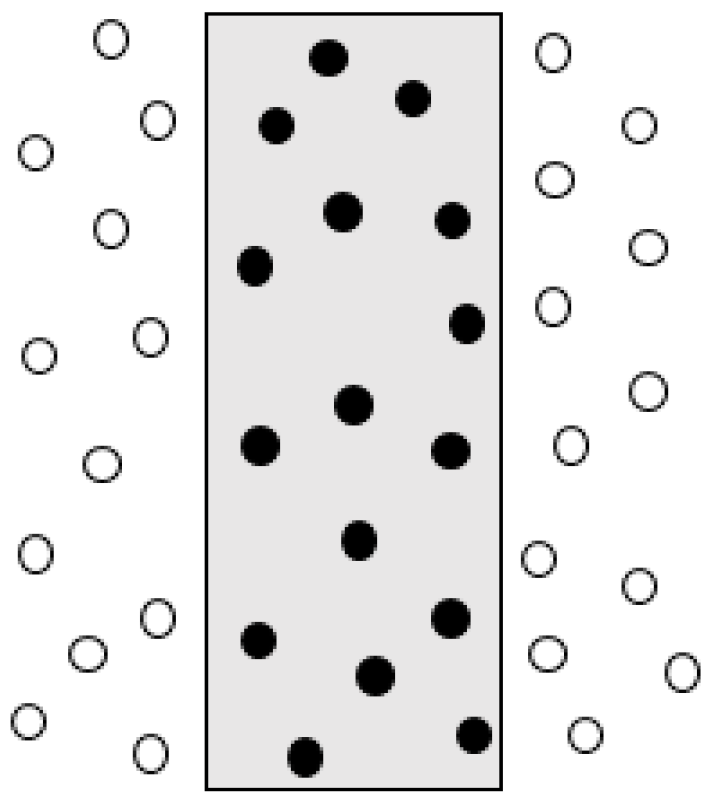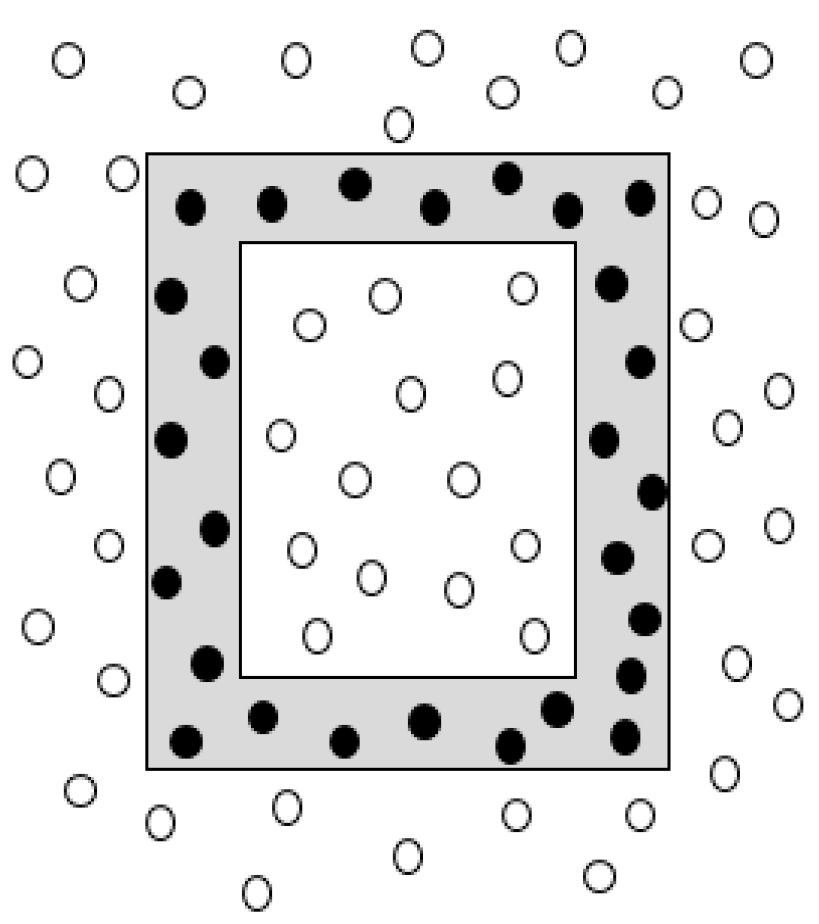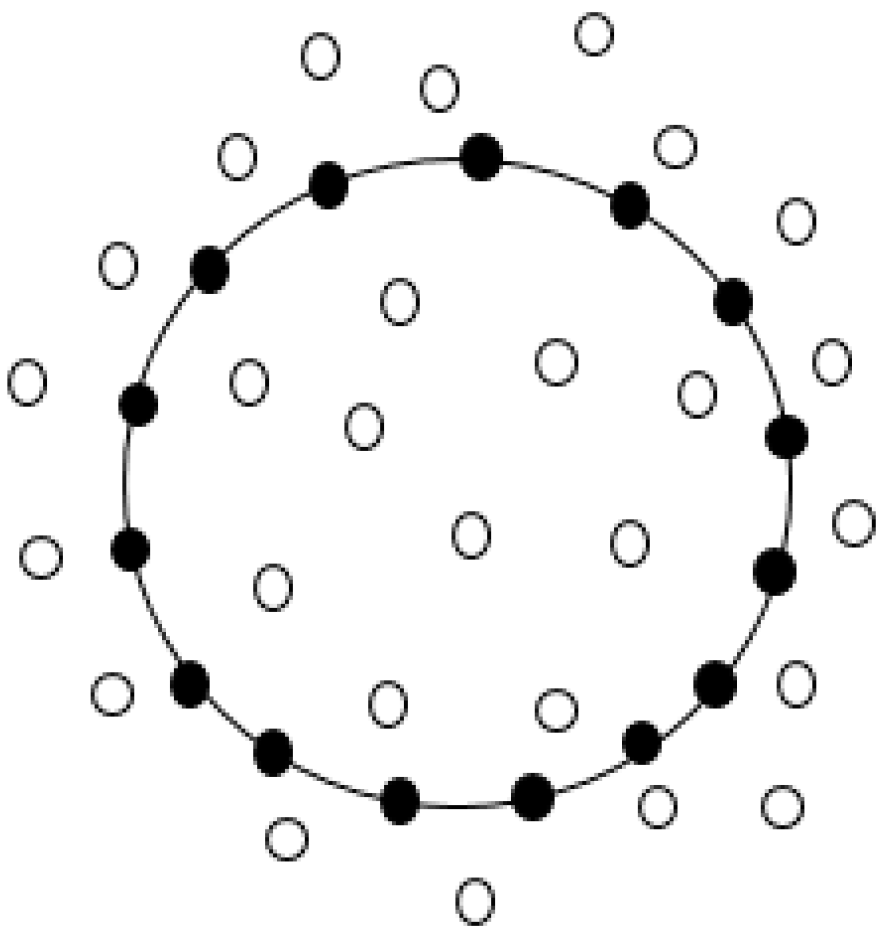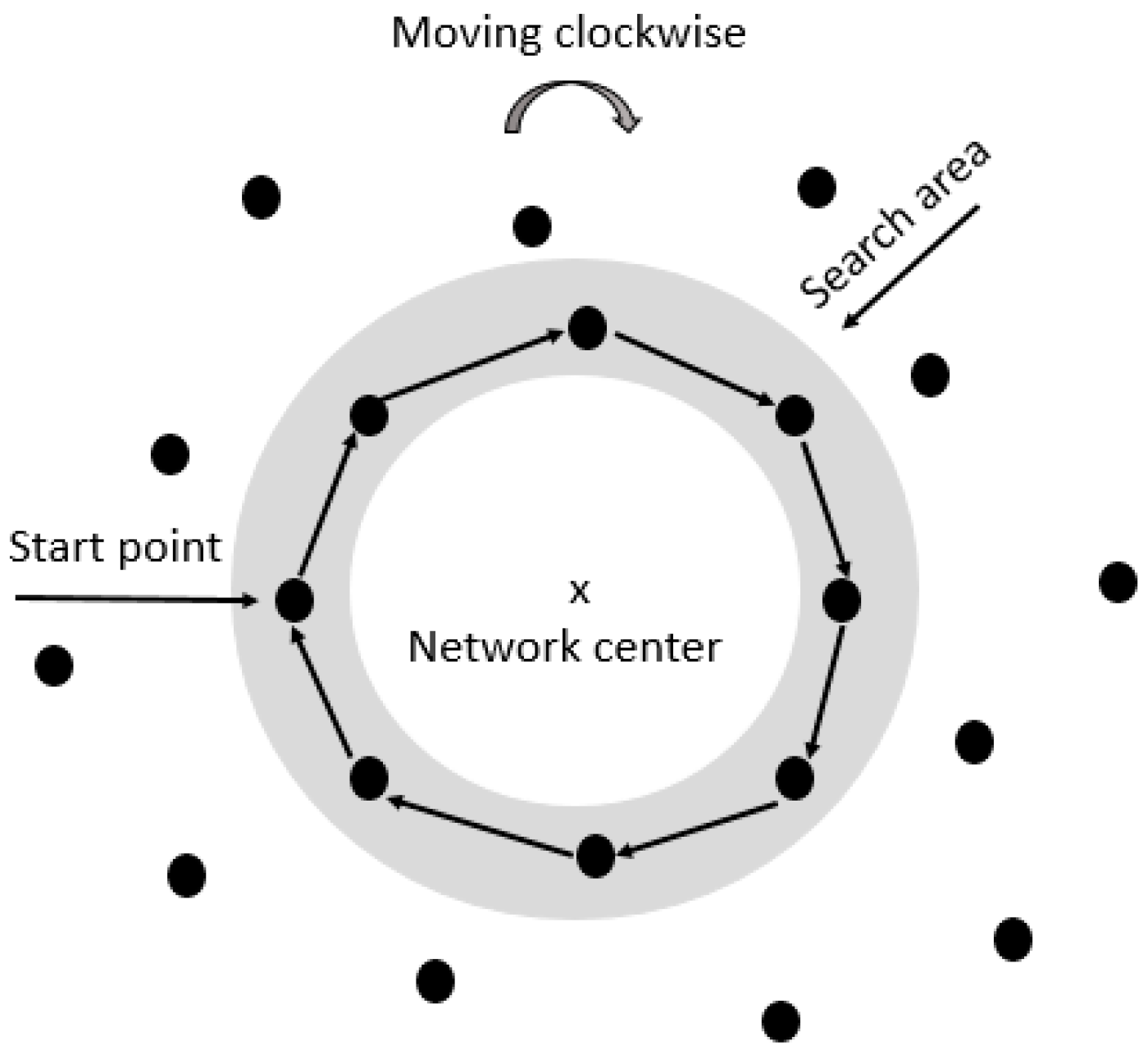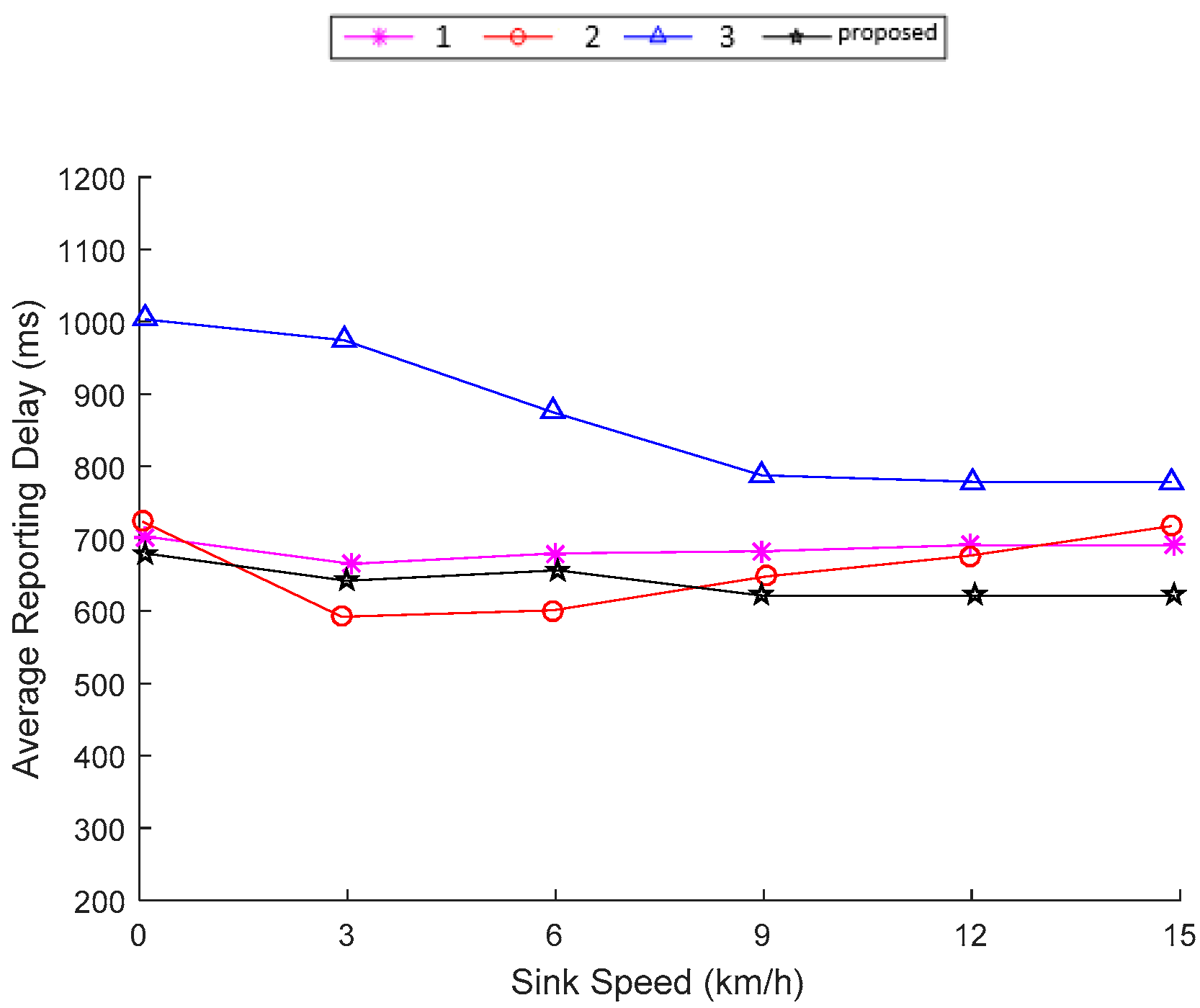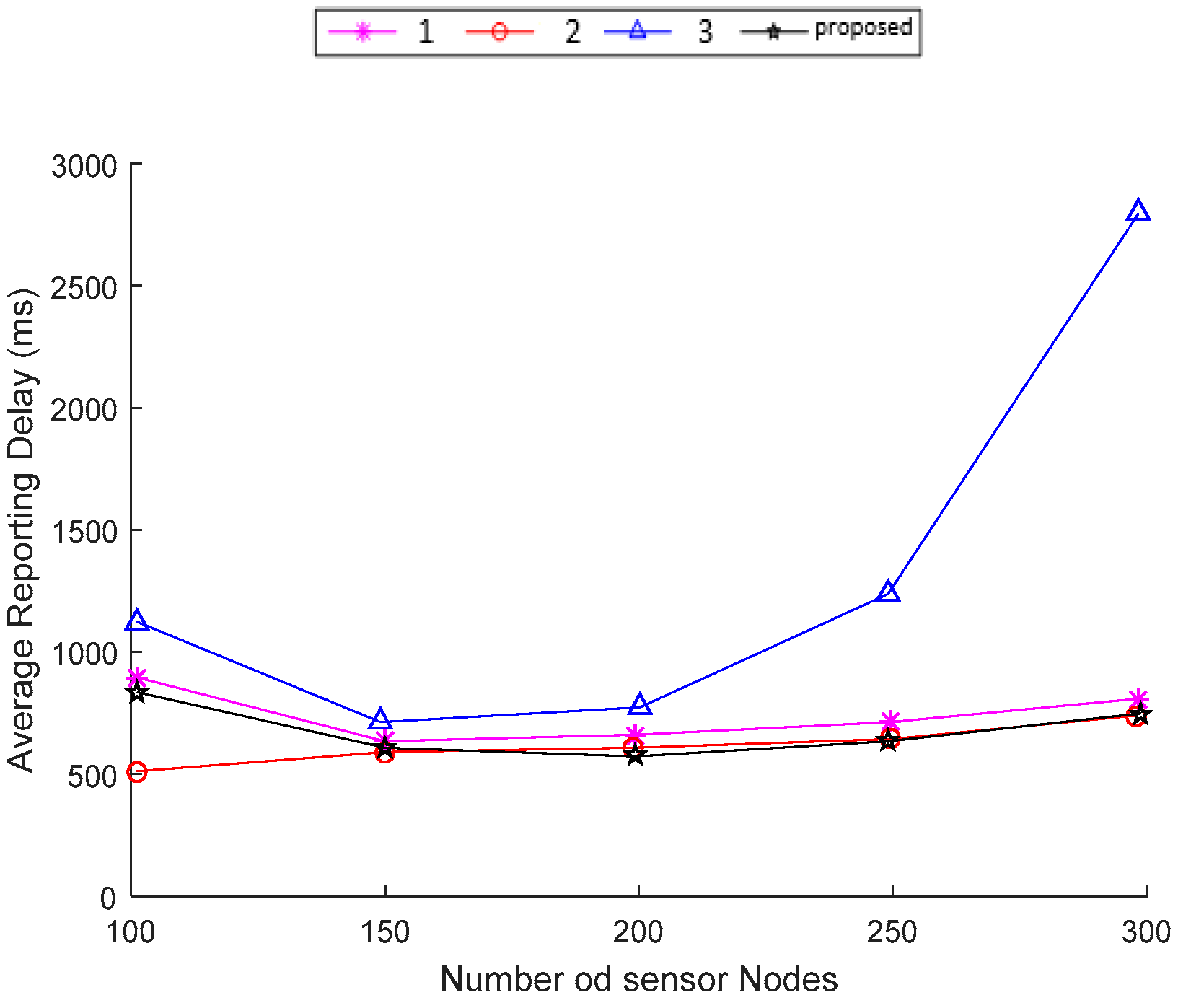1. Introduction
Comprehensive knowledge about railway transportation needs, such as urban, suburban and intercity rail, provides the possibility of developing railway system. During two last decades, by increasing the demand for using railway services, general railway infrastructure, particularly communication system, are quickly developing. In the past wired communication systems were used for signaling and data communication in the railway industry but recently wireless communication systems have emerged as alternatives to supplant wired systems. Railway communication and signaling systems are used to monitor the condition of trains in order to maintain reliable, safe and secure operations [
1].
Different nations are highly focused on the importance of developing the rail transportation network together with providing the measures for replacing road transportation due to its advantages for reducing the fuel consumption, increasing safety and convenience, as well as lower environmental pollution and higher employment.
In recent years, with the sharp increase in the need for transportation, better and smarter monitoring mechanisms, with monitoring in real time and early warning at times when there are dangerous conditions in the way of railway transportation, is needed to safeguard railway transportation safety. Wireless sensor networks, with advantages such as strong compatibility, easier establishment and lower costs, are considered as a choice for designing a system by creating better and more secure mechanisms in time to warn of the risks in rail systems [
2].
The mechanism for presenting the sign and indicator is called the “signal” or “signal device”. Railway signals are a means of communication beyond the range of the voice. Current methods of signaling and train control systems are: communications-based train control (CBTC) systems; advanced train control systems (ATCS); and command, control and communications systems (CCCS). Incremental train control systems (ITCS), positive train control (PTC), positive train separation (PTS), and the European train control system (ETCS) are the new systems developed to enhance the safety and security of train operations [
1].
General methods used for signaling and monitoring in the railways are shown in
Figure 1.
In the late nineteenth century, a railway signaling and monitoring system was developed to create a more secure, quicker system and generally promote the quality and quantity of this complex. Ongoing inventions in railway technology came with continuing increases in the level of creation of new infrastructure in the field of communication and signaling (C & S) in railways. Since 1840, semaphore signals technologies were created in the UK, gradually developed, and were replaced by wireless communication technology in the modern era. Since that time, most companies have continuously tried to improve and promote C & S technology [
1].
Due to their high usage of the rail transportation system for increasing the security, efficiency and speed of railways, nations such as the USA, China and India have simply used the wireless sensor network and presented different plans as well.
Initially, it was vital to develop and manage railway infrastructure systems; thus, they turned to intelligent systems in a short time for better management. One of the key sections of this management was situation management. Situation monitoring in wireless sensor networks deals with diagnosing and detecting the defects in the existing system in railway infrastructure before the occurrence of any error, fault or defect [
3]. The wireless receiver network collects information about safety of railway infrastructure when the train is moving along rail lines and then transmits it to the base station [
4].
Figure 2 indicates the situation monitoring by a wireless sensor network [
5]. As you can see, sensor nodes located on board are also connected to related objects such as rails, tunnels, locomotive, wagons and bridges, and transmit the collected data by Bluetooth or Wi-Fi technology to the base station. The base station forwards the data collected by sensors by using general packet radio service GPRS and/or satellite to the central control server.
Supervision on railway lines is one of the important plans of wireless sensor networks. Sensor network techniques assist in diagnosing any defect in the railway lines and preventing any probable event. As could be seen in
Figure 3, in the discussed plans [
1,
2,
4,
6,
7,
8,
9,
10], a base station or sink in the central control department delivers data collected by existing sensors in the route or in the train to the central server for data analysis and issuing necessary commands.
Considering the advantages of a mobile sink, including longer network life, lower power consumption, load balancing by moving the sink, ease of data collection, and so forth, the method was proposed based on the moving sink that is optimal for the plan, as indicated in
Figure 4.
The most important method in routing protocols for a mobile sink is hierarchical structure that aims to reduce the burden of the sink position notification to the network. In this study, we propose a new hierarchical routing protocol for sensor network with mobile sink, which is a reliable and energy-efficient routing protocol that provides rapid delivery of information.
The proposed routing, by combining a routing protocol with a mobile sink, called Ring Routing, and a gravitational search optimization algorithm for the initial selection of ring, increases the lifespan of a sensor network. For better performance of Ring Routing, the primary selection of ring is conducted by using a gravitational search algorithm causing an increase in the sensor network’s lifespan.
In addition to increasing the lifespan, railway monitoring by the mobile sensor network causes:
Detection of maintenance requirements;
Accurate information to be obtained from trains on the move and rail paths and stations on the way to be checked to send the necessary commands;
maintain process tolerances;
Saved money and time for businesses;
Reduction of the number of incidents relating to signaling faults and failures;
Better communication between drivers and signalers at any time from any point of the station.
2. Related Work
A wireless sensor network (WSN) is a wireless network comprising independent distributed devices applying the use of a sensor for the supervision of physical and/or environmental conditions; these are small, cheap and intelligent sensors.
The wireless sensor network is a distributed, autonomous and self-organizing system comprised of large number of small sensor nodes whose operation requires low energy [
5].
A WSN is a self-organized network including a set of low power nodes with limited transmission range and a sink node [
10].
Wireless systems have been used since early 1980s. Serious work has been done on wireless sensor networks since 1980 with the distributed sensor networks project in the Defense Advanced Research Projects Agency (DARPA). The first movement in wireless sensor networks research was begun in 1998.
WSNs are typically used in dynamic and complex environments and are becoming important in a large variety of real applications, from scientific to military domains, such as surveillance or disaster recovery, monitoring and other applications [
11]. Conducted studies were able to rectify the limitations of this network such as energy, security, topology and lack of central control.
Figure 5 indicates the communicative architecture of a sensor network in which the event occurred and/or questions asked by the sink and the mission delegated to any node causing communication between nodes [
12]. The structure of a sensor network is comprised of a few sensor nodes, sensor field, gateway node and sink to create a regular device for WSN. The gateway node receives the data of sensor nodes and delivers it to the sink as a communicative gate to conduct necessary processing on collected data, and will be provided to the user by communication media such as internet.
Sensor nodes are among important components in this complex and
Figure 6 indicates the general schematic of a sensor node. Any node of a processor could indeed be a receiver/transmitter with a power supply [
13]. Typically, a node is comprised of one or more sensors that can read data from its surroundings [
14].
Any sensor node communicates with other sensors by radio communication; thus, sensor nodes sense the events and phenomena working together. Any node performs works such as data collection and processing and communication with other nodes connected to them for proper routing and sending the processed data.
2.1. Wireless Sensor Network with Mobile Sink
In wireless sensor networks, considering the limited capacity of battery in sensor nodes, energy efficiency is considered as a main issue. With regard to the convergent nature of methods for sending the common wireless sensor network package causing the concentration of data traffic towards the sink, nodes likely discharge their batteries before other nodes when coming close to static sinks. This results in issue of energy holes [
15,
16], and a disruption in topology. In addition, this issue may separate the sinks preventing the delivery of sensor data traffic. Thus, mobile sinks have been proposed and provided as a solution for solving this problem [
17,
18,
19,
20].
Load balancing implicitly by the movement of the sink assists in shifting the hotspots around the sink and the development of drainage, attaining even energy consumption and increasing the lifespan of the network [
21].
In addition, mobile sinks increase network connection by accessing to compartments separated from the network for data retrieval; otherwise, in a static sink, it might be inaccessible [
22,
23].
Noticing the situation of the mobile sink in relation to the network is the main issue for any routing protocol. For resolving this problem, the hierarchical routing protocols have been proposed.
Such an approach removes the need for an extended network of sink notices and considerably reduces the overhead of position notification, as well as by an increase in the energy efficiency of the network.
Some of the most influential hierarchical routing protocols of mobile sink include Two-Tier Data Dissemination (TTDD) [
24], Grid-based Energy-Efficient Routing [
25], Honeycomb Tessellation (HexDD) [
26], Hierarchical Cluster-based Data Dissemination (HCDD) [
27], Quad-tree Based Data Dissemination Protocol (QDD) [
28], Line-based Data Dissemination [
29], Railroad [
30] and Ring Routing [
31].
Moreover, three selected methods with a proposed method have been introduced and compared to review their advantages and disadvantages.
2.2. Reviewing Mobile Sink Routing Protocol
There are many approaches for issue of routing in a wireless sensor network with mobile sinks; the most important method that has been extensively used is hierarchical mobile sink routing protocols. The purpose of these methods is reducing the load of sink position notification to the network by creating a layer of hierarchical nodes imposing different dynamic roles to sensor nodes. In addition, we introduce several methods.
The LBDD (line-based data dissemination protocol) [
32] defines a wide vertical strip of nodes that are horizontally centered on the area of deployment. The nodes positioned inside of the band are called in-line nodes. This band represents an area of appointments for queries and data storage (
Figure 7).
The nodes can access the line by a straightforward mechanism [
33].
The LBDD protocol [
34] assumes that each node knows its geographical position and the coordinates of the interest area. LBDD uses then a geographic routing.
The operation of LBDD consists of two main steps:
- -
Dissemination: when a node detects a stimulus, the data is generated and sent to the nearest inline-node;
- -
Collection: to collect different data, the sink sends a perpendicular query to the band.
The first in-line node which receives the query will propagate it in both directions of the band to attain the nodes with the required data. The data will be then sent directly to the sink.
Line-based data dissemination is yet relying on dissemination for disseminating the data search along the line. The line must be extended enough to reduce the main points. Therefore, particularly for large grids, in-line current may considerably increase total energy.
A railroad [
30] constructs a structure called the rail, which is a closed loop of a strip of nodes, shaped to reflect the outline of the network (
Figure 8). The nodes on the rail are called rail nodes. When a node has sensor data, it sends some information about this data to the nearest rail node that constructs a station, which is a portion of the rail centered on the rail node. The sink searches the rail for data and when it attains to station node, it notifies the source from sink position and data is directly sent to the sink. One of the key differences of railroads with line-based data dissemination is that the sink search is traveling on the rail by single molds instead of dissemination. To ensure that a search with a node is faced with data, stations must cover the width of the rail. Using the stations reduces the need to extended disseminations in the rail, and it is considered an advantage over line-based data dissemination together with assisting the protocol scalability. However, it is expected that delays for delivering the railroad data is higher than line-based data dissemination; this is because searches must travel by a much longer structure. Once a search attains to a station, the source node must be informed from the sink position to begin data dissemination, because data is stored in the database in the stations, and therefore increases the delay for data delivery.
Ring Routing [
31] creates a ring structure and its purpose is combining the easy accessibility of grid structures with the capability of easy change in the column structures (
Figure 9). It also reduces the redundancy of routing control packages by combining the minimum quantity of nodes in the ring structure and uses a simple and efficient mechanism for sharing the sink position notification among ring nodes. A ring might be created with low overhead, like structures used in region-based methods (for example, line-based data dissemination, railroad). On the other hand, Ring Routing relies on a minimum inefficient dissemination value that is extensively used in region-based protocols. Ring Routing is a targeted routing protocol for wide-scale wireless sensor network located externally with fixed sensor nodes and a mobile sink.
3. Proposed Method
Ring Routing is a hierarchical routing protocol based on a virtual ring structure which is designed to be easily accessible and easily reconfigurable. Ring Routing [
31] is a secure and energy efficient routing protocol providing quick data delivery. Wide simulation was done for evaluating the performance of Ring Routing, and it indicated that it performs better than the existing mobile sink routing protocol, whether LBDD [
29] and Railroad [
30] based on energy consumption, lifespan and measures for delay in reporting the routing data. The ring performs almost better than its competitors in all states. According to what mentioned above, and for the better performance of Ring Routing, the initial selection of the ring is conducted by using a gravitational search algorithm causing increased lifespan of the network. The ring protocol imposes three roles to sensor nodes: ring node; normal node, and; anchor node. Ring nodes form a circular structure that is a closed ring of the width of the node (
Figure 10). The basis for Ring Routing involves (a) noticing the sink position to the ring, (b) normal nodes obtaining the information about sink position from the ring at any time required and (c) nodes disseminating their data by anchor nodes performing as factors for connecting the sink to the grid. These three roles of sensor are not static; it means that the role of sensor nodes might be changed during operation from wireless receiver network. The network center is marked with an “X” in various example ring structures shown in
Figure 10.
After the establishment of a wireless sensor network, a ring is initially made by following mechanism, namely, a radius of the initial ring must be determined. Nodes closer to the ring that has been defined by this radius and the center of grid are determined by a specific threshold to act as a nomination for converting to the ring node. By beginning from a specific node (for example, closest node to the left side of the point in the ring), by geological transmission in a given direction (in clockwise/counterclockwise direction), ring nodes are selected by using gravitational search random optimization algorithm to attain the beginning node and complete the closed ring as indicted in
Figure 11. More, we explain gravitational search algorithm (GSA) detailed as below.
In this section, gravitational search optimization algorithm is introduced based on gravitational law. The gravitational search algorithm (GSA) is a nature-inspired algorithm, which is based on Newton’s law of gravity and the law of motion [
35]. In the proposed algorithm [
36,
37,
38], some factors are considered as objects and their performance is measured as their mass. The algorithm is comprised of collection of searcher agents that interact with each other through the gravity force [
35]. All such objects attract themselves by gravity and this force may cause the movement of all objects towards heavier masses. Therefore, masses those are together, having direct connection by gravity. Heavier masses, according to equation, move slower than lighter objects; this ensures the step for exploiting the algorithm.
In GSA, any mass (factor) has four characteristics including place, inertial mass, gravitational active mass and gravitational passive mass. The place of the mass is according to the solution of the problem and gravitational and inertial masses are determined by using the fitness function.
On the other hand, any mass provides a solution, and an algorithm is developed by properly setting the inertial and gravitational mass. Over time, objects are expected to be attracted towards heavier objects. This provides an optimal solution for search space.
Different steps for gravitational search algorithm detailed as below:
Identifying the exploration space;
Random initialization;
Xid represents the positions of the
ith agent in the
dth dimension, while
n is the space dimension.
Proportional equations of factors;
For minimization or maximization problems, the fitness evolution is performed by evaluating the best and worst fitness for all agents at each iteration.
Changing the gravitational constant, G(t), best(t) and worst(t) in the order of max and min value, fitness proportional to factor “i” in time “t” and mass value of Mi(t) with i = 1, 2, …, N;
Gravitational constant
G:
Calculating the general force in different directions;
is the total force.
Calculating the velocity and acceleration;
Velocity of the agents at the next iteration (
t + 1) are computed.
Acceleration of the
agents at iteration
t is computed.
Repeating steps c to g until stopping the conditions has been attained;
End.
Therefore, we only recommend factors with high mass for applying force to each other.
After selecting the initial nodes for creation of ring by gravitational search algorithm, then the neighborhood ring nodes of any normal node will be marked.
Through sink movement, anchor nodes are selected to the movement of their neighbors. Anchor nodes perform as a representative managing the communication between sink and sensor nodes.
Due to the presence of anchor node, when a source node obtains the fixed location of the current anchor node, it could directly transmit its data by geographical transmission to it and the anchor node will reflect these data to the sink and completes data dissemination.
4. Simulation Results
The performance of the proposed routing has been evaluated by simulations done in a MATLAB modeling environment. A topology of 200 sensor nodes deployed randomly on an area of 600 × 600 m2 is used for simulations. A single sink moves randomly in the area of deployment with constant speed. Experiments model 60 min from simulation time. Each case is simulated 20 times with different seeds in order to eliminate the effect of the stochastic nature of some simulation events. On the other hand, the lifespan of each node is equal to the end of the battery life of each node. Wide ranges of different scenario with varying network sizes and sink speed values are defined and used.
The default parameters used in our simulations are presented in
Table 1.
Performance Ring Routing has been compared with gravitational search random optimization algorithm with a ring, line-based data dissemination and Railroad based on determined performance measures:
- 1-
Average energy consumption per any node;
- 2-
Average report delay.
Figure 12 shows the average energy consumptions of proposed method, Ring Routing (method 1), line-based data dissemination (method 2) and Railroad (method 3) for varied sink speed values. The average energy consumption of proposed routing is lower than three other states, and this will make the performance of this method better. Line-based data dissemination for lower speeds has better performance than Railroad, however, it has a reverse relation by increasing the speed. Line-based data dissemination uses the broadcast method for disseminating data search along with line structure, and an increased sink speed results in an increased number of dissemination followed by increased energy consumption. On the other hand, in the Railroad, instead of the dissemination method, searching is shared by unique forms along with the rail until a station has been created. Thus, Railroad performs better than line-based data dissemination for quicker sink speeds.
Figure 13 shows the average reporting delays of proposed method, Ring Routing, line-based data dissemination and Railroad for different sink speeds. In most cases, line-based data dissemination performs to some extent better than proposed routing, and Ring Routing has also a performance close to proposed routing; while Railroad has the worst performance for all above cases. In the proposed routing, Ring Routing and Railroad, the request/answer mechanism for spatial data of anchor node has been used, while in line-based data dissemination, a direct in-line data dissemination was used to remove the cost of a delay for answering the request of spatial data of the anchor node.
However, this provides the condition for linear nodes to process large amounts of data causing high energy consumption in line-based data dissemination.
Grid density and total traffic loads depend on the grid size, thus, besides the speed parameter, which is an effective parameter on performance of wireless sensor network, the number of sensor nodes will also have considerable effect on network performance. Thus, performances of protocols were also simulated in different numbers of sensor nodes (100, 150, 200, 250, and 300) on a fixed area of 600 × 600 m2.
Figure 14 shows that for all states, the average performance of energy consumption in the proposed method is better than Ring Routing, line-based data dissemination and Railroad. The proposed method, Ring Routing and line-based data dissemination, have stable performances in different number of sensor nodes; considering the performance of Railroad, when a node has sensor data, some information about these data would be sent to the closest node of the rail and a station would be created; naturally, by increasing the number of nodes, number of created stations and number of dissemination would be also increased; this results in considerable complications in performance of railroad for larger grids.
Figure 15 indicates average reporting delay of protocols considering the change in the number of sensor nodes has patterns similar to average curves for energy consumption. Line-based data dissemination, Ring Routing and the proposed routing among a given number of nodes in the range have stable performance, while the Railroad performance worsens with increases in the number of nodes and the size of the grid. Routing for the proposed method has better reporting delay values than other algorithms.
As seen in
Table 2, the performances of four introduced protocols have been compared.
5. Conclusions
Railway lines have a very long history. Maintenance and repair are the fundamental activities for the benefit of rail lines and, because of this, the issue of signaling and monitoring in the railway is very vital for safety purposes. In railway systems, a signaling system critically controls the equipment and safer operations for trains [
9]. Currently, signaling systems have been launched with different brands and wire networks that are suitable for ensuring their higher reliability, however, their installation and maintenance costs are high. Therefore, we decided to use wireless sensor networks in rail signaling to meet the objectives as stated in this study, such as reducing the occurrence of errors by employees, receiving accurate data from traveling trains and reviewing the rail routes, creating a safe system, reducing the usage of wire networks and reducing the cost and time for repairing defects. According to the discussed goals and the advantages of mobile sinks, as stated above, we provided a proposed method based on a mobile sink proportional to this project.
In this study, by improving the Ring Routing protocol, we proposed a new mobile sink routing protocol based on advantages and disadvantages of existing protocols, as in the literature review. The proposed routing is a hierarchical routing protocol based on a virtual ring structure that has been designed for easier access and reconfiguration.
The performance of proposed routing is evaluated extensively by simulations conducted in the MATLAB Modeler environment. A wide range of different scenarios with varying network sizes and sink speed values are defined and used. Results for evaluating the comparative performance of proposed routing have been presented with three efficient protocols, that is, a mobile sink, Ring Routing, line-based data dissemination and Railroad. Results indicate that proposed routing is indeed a protocol with efficient energy increasing the lifespan of the network and values of reporting delays indicate that the proposed routing is suitable for time-sensitive usages.
6. Future Works
For improving the energy consumption and increasing the lifetime of network, considering the limitation of existing network, one alternative for improving this challenge is using a few mobile sinks for collecting the data throughout the network. Thus, it is recommended to modify the proposed routing for supporting various mobile sinks. Logical and effective modification uses the advantages of various sinks with additional mechanisms and structures. Thus, by proposing the development and changes in the proposed routing with various mobile sinks, the network or grid could perform more efficient. Such an approach requires justifying additional costs for establishment of more sinks in wireless sensor network. In addition, it is needed to discover different mobility patterns such as controlled or mobile sink mobility instead of fixed speed sink mobility.
